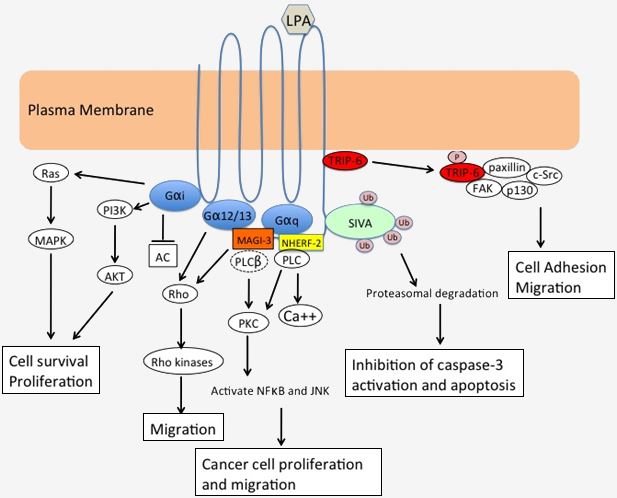Introduction of LPAR2
LPAR2, encoded by LPAR2 gene, is a G-protein coupled receptor that belongs to the endothelial differentiation gene (EDG) family of receptors. The receptor is about 39.1 kDa and consists of 351 amino acid residues. It has seven transmembrane regions, three numbered extracellular and intracellular loops. LPAR2 mRNA is expressed in a variety of tissues including human testis, leukocytes, spleen, thymus, pancreas, and bone marrow. Most researches indicate that LPAR2 is involved in the regulation of cell survival, proliferation, and migration.
| Basic Information of LPAR2 | |
| Protein Name | Lysophosphatidic acid receptor 2 |
| Gene Name | LPAR2 |
| Aliases | EDG4, LPA2, EDG-4, LPA-2 |
| Organism | Homo sapiens (Human) |
| UniProt ID | Q9HBW0 |
| Transmembrane Times | 7 |
| Length (aa) | 351 |
| Sequence | MVIMGQCYYNETIGFFYNNSGKELSSHWRPKDVVVVALGLTVSVLVLLTNLLVIAAIASNRRFHQPIYYLLGNLAAADLFAGVAYLFLMFHTGPRTARLSLEGWFLRQGLLDTSLTASVATLLAIAVERHRSVMAVQLHSRLPRGRVVMLIVGVWVAALGLGLLPAHSWHCLCALDRCSRMAPLLSRSYLAVWALSSLLVFLLMVAVYTRIFFYVRRRVQRMAEHVSCHPRYRETTLSLVKTVVIILGAFVVCWTPGQVVLLLDGLGCESCNVLAVEKYFLLLAEANSLVNAAVYSCRDAEMRRTFRRLLCCACLRQSTRESVHYTSSAQGGASTRIMLPENGHPLMDSTL |
Function of LPAR2 Membrane Protein
LPAR2 is activated via interaction with its ligands, lysophosphatidic acid (LPA), and transduces extracellular signals into intracellular downstream signaling molecules, such as phosphatidylinositol 3-kinase, phospholipase C, Ca2+, Ras, Rac, and Rho. The activated LPAR2 is involved in the regulation of cellular responses including cell growth, differentiation, survival and migration. It has been indicated that LPAR2 plays an essential role in the progression of many cancers, acting as a potential predictor and prognostic biomarker for tumors. LPAR2 may be associated with the production of estrogens and androgens, involved in the progression of endometrial carcinoma and ovarian endometriotic cysts. The high LPAR2 levels are associated with the poor outcomes of breast cancer with shorter overall survival. However, the inhibition of LPAR2 can suppress the migration of ovarian cancer cells. These also suggest that LPAR2 can be considered as a promising therapeutic target for many types of tumor treatment.
 Fig.1 The mechanism of LPA signaling transduction. (Knowlden, 2013)
Fig.1 The mechanism of LPA signaling transduction. (Knowlden, 2013)
Application of LPAR2 Membrane Protein in Literature
The study indicates that the high production of LPAR2 and LPAR4 is observed in ovarian endometriotic cysts and positive correlations of both these receptors with the expression of E2 and P4 receptors. Hence, LPAR2 and LPAR4 are mainly responsible for LPA activation in ovarian endometriotic cysts and those receptors may serve as the promising biomarkers of the endometriotic cysts.
The study shows that LPA-LPAR2 signaling pathway may promote acquisition of malignant properties during tumor progression in MG-63 cells.
The study reveals that LPA1 and LPA2 induce phosphorylation of ezrin/radixin/moesin (ERM) proteins that are membrane-cytoskeleton linkers involved in cytoskeletal reorganization and formation of membrane protrusions in OVCAR-3 cells. Besides, the silencing of LPA1 and LPA2 can abolish OVCAR-3 cells migration, suggesting that these receptors could provide the potential therapeutic targets for metastatic ovarian cancer.
The study indicates that LPAR1 and LPAR2 are positively associated with proliferation SRD5A2 in endometrial carcinoma (EC) tissue, suggesting that intratumoral estrogen metabolism and synthesis are pivotal in endometrial carcinoma progression, with the involvement of LPA in this process.
The study shows that elevated plasma levels of LPA and aberrant expression of LPA receptors in the endometria may be associated with the development of adenomyosis.
LPAR2 Preparation Options
Based on the versatile Magic™ membrane protein production platform, Creative Biolabs can provide many flexible options for soluble and functional target protein, from which you can always find a better match for your particular project. Aided by our versatile Magic™ anti-membrane protein antibody discovery platform, we also provide customized anti-LPAR2 antibody development services.
As a forward-looking research institute as well as a leading custom service provider in the field of membrane protein, Creative Biolabs has won good reputation among our worldwide customers for successfully accomplishing numerous challenging projects including generation of many functional membrane proteins. Please feel free to contact us for more information.
Reference
All listed services and products are For Research Use Only. Do Not use in any diagnostic or therapeutic applications.